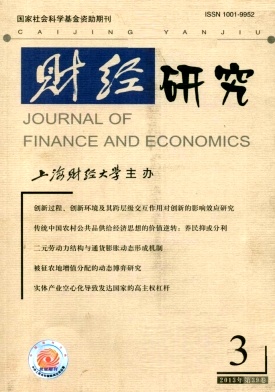不确定技术变革条件下中国制造业的产业追赶机制研究
财经研究 2013 年 第 39 卷第 03 期, 页码:124 - 135
摘要
参考文献
摘要
文章通过建立层次回归统计模型,检验了不确定技术变革条件下不同产业技术体制内的制造业企业进行技术追赶并获取后发优势的路径和机制。研究发现:第一,不同产业技术体制下驱动制造业企业获取后发优势的过程是有差异的;第二,不确定的技术变革在技术追赶过程中影响了企业获取后发优势,技术变革的动态性和复杂性越强,为制造业企业获得后发优势创造了越多机会;第三,在不确定技术变革条件下,不同技术体制内的制造业企业采用突破性技术追赶战略更容易获得新后发优势,而采用渐近性技术追赶战略则更容易获取后发优势。
[1]高旭东.“后来者劣势”与我国企业发展新兴技术的对策[J].管理学报,2005,3:291-294.
[2]刘建新,王毅,吴贵生,等.后发国家产业技术追赶模式新探:单路径、双路径与多路径[J].科学学与科学技术管理,2011,(11):93-99.
[3]苏楠,吴贵生.核心元件产业追赶问题研究:以我国数控系统产业发展为例[J].技术经济,2011,(8):1-6.
[4]王玉荣,杨震宁,李军.竞争环境和技术战略对制造业创新绩效的影响[J].科研管理,2011,(7):25-33.
[5]谢伟.中国消费电子业的崛起[M].北京:中国金融出版社,2004.
[6]杨震宁,李东红.中国制造业企业创新:行业竞争,嵌入集群的社会资本与技术战略选择[J].财贸经济,2010,(6):98-105.
[7]Amsden A,Chu W.Beyond late development[M].Cambridge,MA:MIT Press,2003.
[8]Breschi S,Malerba F,Orsenigo L.Technological regimes and schumpeterian patterns of innovation[J].Economic Journal,2000,110(463):388-410.
[9]Duncan R B.Characteristics of organizational environments and perceived environment uncertainty[J].Administrative Science Quarterly,1972,17(3):313-327.
[10]Fransman M.Japan’s computer and communication industry[M].Oxford:Oxford Uni-versity Press,1995.
[11]Freddi D.The integration of old and new technological paradigms in low and medium-tech sectors:The case of mechatronics[J].Research Policy,2009,38(3):548-558.
[12]Lee K,Lim C.Technological regimes,catching-up and leapfrogging:Findings from the Korean industries[J].Research Policy,2001,30(3):459-483.
[13]Malerba F.Sectoral systems of innovation:Concepts,issues and analyses of six major sectors in Europe[M].Cambridge:Cambridge University Press,2004.
[14]Park K,Lee K.Linking the technological regime to the technological catch-up:Analy-zing Korea and China’s Taiwan region using the US patent data[M].Beijing:Tsinghua University Press,2004.
[15]Saviotti P,Krafft J.Industrial dynamics,innovation and development[EB/OL].http://lib.jlu.edu.cn/database_ww.asp,2005.
[16]Tan J,Tan D.Environment-strategy co-evolution and co-alignment:A staged model of Chinese SOEs under transition[J].Strategic Management Journal,2005,26(2):141-157.
[17]Tan J,Litschert R J.Environment-strategy relationship and its performance implica-tions:An empirical study of the Chinese electronics industry[J].Strategic Management Journal,1994,15(1):1-20.
[18]Tseng F M,Chiu Y J,Chen J S.Measuring business performance in the high-tech ma-nufacturing industry:A case study of Taiwan’s large-sized TFT-LCD panel companies[J].International Journal of Management Science,2007,37(3):686-697.
[19]Tushman M L,Anderson P.Technological discontinuities and organizational environ-ments[J].Administrative Science Quarterly,1986,31(3):439-465.
[2]刘建新,王毅,吴贵生,等.后发国家产业技术追赶模式新探:单路径、双路径与多路径[J].科学学与科学技术管理,2011,(11):93-99.
[3]苏楠,吴贵生.核心元件产业追赶问题研究:以我国数控系统产业发展为例[J].技术经济,2011,(8):1-6.
[4]王玉荣,杨震宁,李军.竞争环境和技术战略对制造业创新绩效的影响[J].科研管理,2011,(7):25-33.
[5]谢伟.中国消费电子业的崛起[M].北京:中国金融出版社,2004.
[6]杨震宁,李东红.中国制造业企业创新:行业竞争,嵌入集群的社会资本与技术战略选择[J].财贸经济,2010,(6):98-105.
[7]Amsden A,Chu W.Beyond late development[M].Cambridge,MA:MIT Press,2003.
[8]Breschi S,Malerba F,Orsenigo L.Technological regimes and schumpeterian patterns of innovation[J].Economic Journal,2000,110(463):388-410.
[9]Duncan R B.Characteristics of organizational environments and perceived environment uncertainty[J].Administrative Science Quarterly,1972,17(3):313-327.
[10]Fransman M.Japan’s computer and communication industry[M].Oxford:Oxford Uni-versity Press,1995.
[11]Freddi D.The integration of old and new technological paradigms in low and medium-tech sectors:The case of mechatronics[J].Research Policy,2009,38(3):548-558.
[12]Lee K,Lim C.Technological regimes,catching-up and leapfrogging:Findings from the Korean industries[J].Research Policy,2001,30(3):459-483.
[13]Malerba F.Sectoral systems of innovation:Concepts,issues and analyses of six major sectors in Europe[M].Cambridge:Cambridge University Press,2004.
[14]Park K,Lee K.Linking the technological regime to the technological catch-up:Analy-zing Korea and China’s Taiwan region using the US patent data[M].Beijing:Tsinghua University Press,2004.
[15]Saviotti P,Krafft J.Industrial dynamics,innovation and development[EB/OL].http://lib.jlu.edu.cn/database_ww.asp,2005.
[16]Tan J,Tan D.Environment-strategy co-evolution and co-alignment:A staged model of Chinese SOEs under transition[J].Strategic Management Journal,2005,26(2):141-157.
[17]Tan J,Litschert R J.Environment-strategy relationship and its performance implica-tions:An empirical study of the Chinese electronics industry[J].Strategic Management Journal,1994,15(1):1-20.
[18]Tseng F M,Chiu Y J,Chen J S.Measuring business performance in the high-tech ma-nufacturing industry:A case study of Taiwan’s large-sized TFT-LCD panel companies[J].International Journal of Management Science,2007,37(3):686-697.
[19]Tushman M L,Anderson P.Technological discontinuities and organizational environ-ments[J].Administrative Science Quarterly,1986,31(3):439-465.
引用本文
杨震宁, 李东红, 陈丽. 不确定技术变革条件下中国制造业的产业追赶机制研究[J]. 财经研究, 2013, 39(3): 124–135.
导出参考文献,格式为:





 6365
6365  3032
3032

